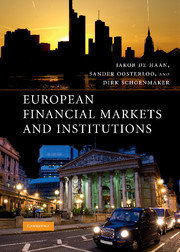Book contents
- Frontmatter
- Contents
- List of Boxes
- List of Figures
- List of Tables
- List of Countries
- List of Abbreviations
- Preface
- Part I Setting the Stage
- Part II Financial Markets
- Part III Financial Institutions
- Part IV Policies for the Financial Sector
- 10 Financial Regulation and Supervision
- 11 Financial Stability
- 12 European Competition Policy
- Index
- References
12 - European Competition Policy
from Part IV - Policies for the Financial Sector
- Frontmatter
- Contents
- List of Boxes
- List of Figures
- List of Tables
- List of Countries
- List of Abbreviations
- Preface
- Part I Setting the Stage
- Part II Financial Markets
- Part III Financial Institutions
- Part IV Policies for the Financial Sector
- 10 Financial Regulation and Supervision
- 11 Financial Stability
- 12 European Competition Policy
- Index
- References
Summary
OVERVIEW
This chapter provides a concise overview of European competition policy, with a focus on financial services. The chapter first defines competition and describes the objectives of EU competition policy, i.e., the maintenance of competitive markets in the EU, as well as the single-market objective. The ultimate goal of competition is to offer consumers greater choice of products and services at lower prices (i.e., to enhance consumer welfare).
The second part of the chapter analyses the economic rationale for competition policy by examining the difference between a perfectly competitive market and a monopoly. In a competitive market, prices are ‘competed’ down and goods or services are produced in the least costly way. Firms are price takers. In a monopoly, there is a single seller in the market who can exert undue market power. The monopolist thus has significant power over the price and is a price setter.
The third part of the chapter elaborates on the four tools of EU competition policy, i.e., the elimination of agreements that restrict competition and abuse of a dominant position, the control of mergers and acquisitions, the liberalisation of monopolistic sectors, and monitoring of state aid. The relevance of these tools is illustrated by a number of practical cases in financial services related to the alleged dominance of MasterCard and the illegal state aid to German, Austrian, and French public banks.
- Type
- Chapter
- Information
- European Financial Markets and Institutions , pp. 371 - 398Publisher: Cambridge University PressPrint publication year: 2009



